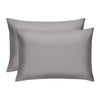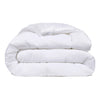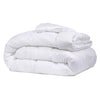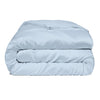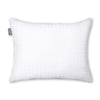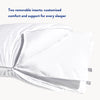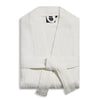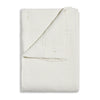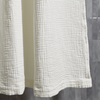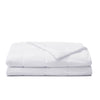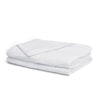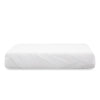The Daily Miracle
How To Get Sap out of Clothes
Published
December 21, 2023
Author
Bridget Reed

Ever been out, embracing the beauty of nature, only to return and find your clothes victim to a splotch of tree sap? It's a common scenario for many outdoor enthusiasts.
While a lovely part of nature, tree sap can be less delightful when it clings to your clothing. However, there's no need to stress. Removing sap from your clothes is not as daunting as it seems, and we're here to guide you through it.
Why Is Sap Such a Challenge?
Let's start by understanding our adversary. Sap is more than just a sticky substance — it's a complex mixture derived from trees, composed of sugars, minerals, and water.
Not only that, but sap is generally not water soluble and only gets harder when exposed to air. This combination gives sap its notorious stickiness and adhesive quality, which is why it clings so stubbornly to fabrics.
The stickiness of sap is due to its high sugar content, which, when exposed to air, becomes hard and difficult to remove. Different fabrics react differently to sap, and this variability necessitates a specific approach depending on whether you're dealing with cotton, polyester, or more delicate materials.
Understanding the nature of sap and the fabric it’s adhered to is the first step in effectively dealing with this sticky situation.
How Do I Pre-Treat Sap?
The pre-treatment phase is crucial in the battle against sap. Acting swiftly and with the right techniques can mean the difference between a simple clean-up and a stubborn stain. Once you've identified the sap, begin by gently scraping off as much as possible.
Everyday items like a butter knife or a credit card can be effective tools for this task. The goal here is to lift the sap without pressing it further into the fabric or causing any damage. If you're dealing with a delicate fabric, proceed with extra caution to avoid any snags or tears.
Freezing the sap is another ingenious method, particularly effective for thicker, more robust fabrics. By applying ice directly to the sap or placing the garment in the freezer, the sap hardens, making it much easier to remove. This method is less effective on thinner, more delicate fabrics where the sap might have penetrated deeper into the fibers.
In such cases, placing a piece of wax paper over the sap before freezing can help protect the fabric. Once the sap is frozen, use a dull knife or a spoon to gently chip it away. Patience is key in this step — rushing can cause more harm than good.
Selecting the Right Cleaning Solutions
The right cleaning solution can make sap removal a breeze. For those who prefer a DIY approach, rubbing alcohol is a go-to option.
It's not just effective but also generally safe for most fabrics. Apply it to a cotton ball or a soft cloth and gently dab at the sap, taking care not to spread it further. As the alcohol breaks down the sap, you'll notice it lifting from the fabric.
If you're dealing with a more stubborn sap stain or prefer natural solutions, oil-based products like eucalyptus oil, cooking oil, or even peanut butter can be surprisingly effective. These oils work by breaking down the sap's sticky bonds, allowing you to wipe it away more easily.
It's a gentler approach, especially suitable for delicate fabrics where harsher chemicals might cause damage. Apply a small amount of the oil-based solution to the sap and let it sit for a few minutes to penetrate and break down the sap. Then, gently wipe away with a clean cloth.
For those who prefer a more straightforward, ready-made solution, our Miracle Laundry Detergent Sheets are a perfect choice. These sheets are formulated to tackle tough stains like sap while being gentle on both your skin and the environment. They contain powerful cleaning agents that can break down even the most stubborn sap without the need for harsh chemicals.
Simply apply a small piece of the detergent sheet to the stained area, add a little water, and gently rub it in. The sheet will create a mild, effective lather that helps lift the sap from the fabric.
How Do I Approach Post-Cleaning Care for Sap Stains?
After successfully treating the sap stain, it's time to focus on post-cleaning care. This step is all about ensuring that the garment returns to its pristine condition.
Begin by washing the garment according to its care label. Pay attention to the water temperature and cycle recommendations. Some fabrics may require a gentle cycle or cold water to prevent damage.
When it comes to drying, air drying is the safest bet, especially for delicate items. Lay the garment flat on a clean, dry towel away from direct sunlight and heat sources. This method helps preserve the fabric's shape and texture. If the care label allows for machine drying, opt for a low heat setting to prevent any potential shrinkage or damage.
It's also a good idea to inspect the garment after washing but before drying. If any trace of the sap remains, repeat the cleaning process. Drying a garment with sap still on it can set the stain permanently, making it much harder to remove.
Thoroughness in this final stage is vital to restore your garment fully. With these steps, you can confidently return your clothes to their original state, free of any sap traces, and ready for your next adventure.
How Can You Prevent Future Sap Heartbreak?
As with most things, prevention is often easier than cure. When planning outdoor activities, think about what you'll be wearing.
Opt for fabrics that are less prone to sap adherence or clothing you’re less concerned about getting a bit dirty. Awareness is also crucial — watch out for trees with visible sap and try to keep a safe distance.
If you’re particularly adventurous or find yourself frequently in sap-prone environments, consider treating your clothes with a fabric protector. These sprays can add a layer of protection, making it easier to clean your clothes should they come into contact with sap.
What About High-Quality Fabrics?
Taking care of high-quality fabrics, like your favorite King comforter or a silk blouse, requires a bit more attention. These materials often need a gentle touch and specific cleaning methods to maintain their appearance and texture. Always refer to the care label first and choose a cleaning method that aligns with the fabric’s needs.
For tougher stains on delicate fabrics, consider consulting a professional cleaner. They have the expertise and the right tools to treat stubborn stains without damaging high-quality materials. The longevity and appearance of your premium fabrics often depend on how you care for them, especially when dealing with challenging stains like sap.
Sappy Endings
Dealing with sap on your clothes doesn’t have to be a sticky nightmare. With these steps — from pre-treatment to post-cleaning care — you’re well-equipped to tackle this challenge. The right approach can make all the difference, whether it's a small sap stain or a more significant smudge.
So go ahead and enjoy your outdoor adventures, knowing that any sap encounters can be easily managed with a little know-how and the right products.
Sources:
Stain Removal Guide | Cleaning Institute


